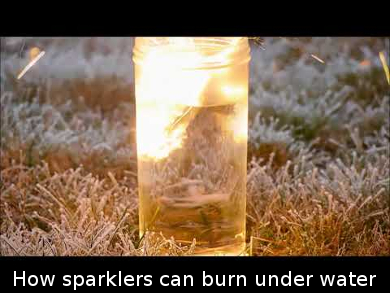A cool Easter experiment and a bit of chemist: The sparkler continues to burn in the egg, even though the oxygen should be used up after a short time due to combustion.
The burning part of the sparkler consists of dextrin, aluminum powder, iron powder, and barium nitrate. Dextrin binds all the components. The easily combustible aluminum provides the energy for combustion. The barium nitrate is the oxidizing agent. The combustion releases oxygen. When the oxygen from the air is used up, the sparker thus provides its own oxygen. The following reactions take place during combustion.
2 Ba(NO3)2 → 2 BaO + 2 N2 + 5 O2
4 Al + 3 O2 → 2 Al2O3
4 Fe + 3 O2 → 2 Fe2O3
C6H10O5 + 6 O2 → 6 CO2 + 5 H2O
The self-generated oxygen “heats” the combustion process. The chemical reactions in a sparkler produce temperatures of up to 1100 °C. Sparkler can not be blown out.
The gases produced by the combustion reaction contain toxic carbon monoxide and nitrogen oxides. Sparklers should, therefore, be burned outdoors or in well-ventilated rooms.
The sparks that the sparkler emits come from glowing iron particles, which are catapulted to the outside while the sparkler burns. These not hot iron particles react with oxygen and ignite to magnetite:
3 Fe (s) + 2 O2 (g) → Fe3O4 (s)
In addition, the gases produced by the burning of the dextrin (H2O, CO2) and the decomposition of the barium nitrate (N2) eject some metal particles from the sparkler.
Also of Interest

How sparklers can burn under water

Chemical look at a hand-held firework

The video shows how to see the yolk in the egg without destroying the egg

🐣🌷🐰 A growing collection of articles and videos on eggs and science



